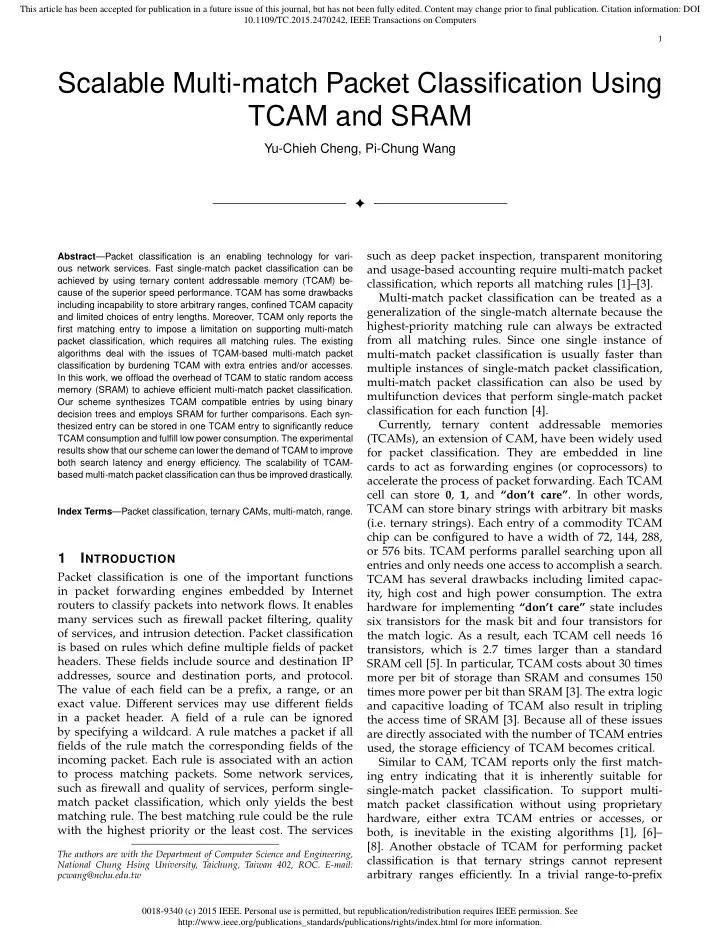

This article has been accepted for publication in a future issue of this journal, but has not been fully edited. Content may change prior to final publication. Citation information: DOI 10.1109/TC.2015.2470242, IEEE Transactions on Computers 1 Scalable Multi-match Packet Classification Using TCAM and SRAM Yu-Chieh Cheng, Pi-Chung Wang ✦ such as deep packet inspection, transparent monitoring Abstract —Packet classification is an enabling technology for vari- ous network services. Fast single-match packet classification can be and usage-based accounting require multi-match packet achieved by using ternary content addressable memory (TCAM) be- classification, which reports all matching rules [1]–[3]. cause of the superior speed performance. TCAM has some drawbacks Multi-match packet classification can be treated as a including incapability to store arbitrary ranges, confined TCAM capacity generalization of the single-match alternate because the and limited choices of entry lengths. Moreover, TCAM only reports the highest-priority matching rule can always be extracted first matching entry to impose a limitation on supporting multi-match from all matching rules. Since one single instance of packet classification, which requires all matching rules. The existing multi-match packet classification is usually faster than algorithms deal with the issues of TCAM-based multi-match packet classification by burdening TCAM with extra entries and/or accesses. multiple instances of single-match packet classification, In this work, we offload the overhead of TCAM to static random access multi-match packet classification can also be used by memory (SRAM) to achieve efficient multi-match packet classification. multifunction devices that perform single-match packet Our scheme synthesizes TCAM compatible entries by using binary classification for each function [4]. decision trees and employs SRAM for further comparisons. Each syn- Currently, ternary content addressable memories thesized entry can be stored in one TCAM entry to significantly reduce (TCAMs), an extension of CAM, have been widely used TCAM consumption and fulfill low power consumption. The experimental results show that our scheme can lower the demand of TCAM to improve for packet classification. They are embedded in line both search latency and energy efficiency. The scalability of TCAM- cards to act as forwarding engines (or coprocessors) to based multi-match packet classification can thus be improved drastically. accelerate the process of packet forwarding. Each TCAM cell can store 0 , 1 , and “don’t care” . In other words, TCAM can store binary strings with arbitrary bit masks Index Terms —Packet classification, ternary CAMs, multi-match, range. (i.e. ternary strings). Each entry of a commodity TCAM chip can be configured to have a width of 72, 144, 288, or 576 bits. TCAM performs parallel searching upon all 1 I NTRODUCTION entries and only needs one access to accomplish a search. Packet classification is one of the important functions TCAM has several drawbacks including limited capac- in packet forwarding engines embedded by Internet ity, high cost and high power consumption. The extra routers to classify packets into network flows. It enables hardware for implementing “don’t care” state includes many services such as firewall packet filtering, quality six transistors for the mask bit and four transistors for of services, and intrusion detection. Packet classification the match logic. As a result, each TCAM cell needs 16 is based on rules which define multiple fields of packet transistors, which is 2.7 times larger than a standard headers. These fields include source and destination IP SRAM cell [5]. In particular, TCAM costs about 30 times addresses, source and destination ports, and protocol. more per bit of storage than SRAM and consumes 150 The value of each field can be a prefix, a range, or an times more power per bit than SRAM [3]. The extra logic exact value. Different services may use different fields and capacitive loading of TCAM also result in tripling in a packet header. A field of a rule can be ignored the access time of SRAM [3]. Because all of these issues by specifying a wildcard. A rule matches a packet if all are directly associated with the number of TCAM entries fields of the rule match the corresponding fields of the used, the storage efficiency of TCAM becomes critical. incoming packet. Each rule is associated with an action Similar to CAM, TCAM reports only the first match- to process matching packets. Some network services, ing entry indicating that it is inherently suitable for such as firewall and quality of services, perform single- single-match packet classification. To support multi- match packet classification, which only yields the best match packet classification without using proprietary matching rule. The best matching rule could be the rule hardware, either extra TCAM entries or accesses, or with the highest priority or the least cost. The services both, is inevitable in the existing algorithms [1], [6]– [8]. Another obstacle of TCAM for performing packet The authors are with the Department of Computer Science and Engineering, classification is that ternary strings cannot represent National Chung Hsing University, Taichung, Taiwan 402, ROC. E-mail: arbitrary ranges efficiently. In a trivial range-to-prefix pcwang@nchu.edu.tw 0018-9340 (c) 2015 IEEE. Personal use is permitted, but republication/redistribution requires IEEE permission. See http://www.ieee.org/publications_standards/publications/rights/index.html for more information.
Recommend
More recommend